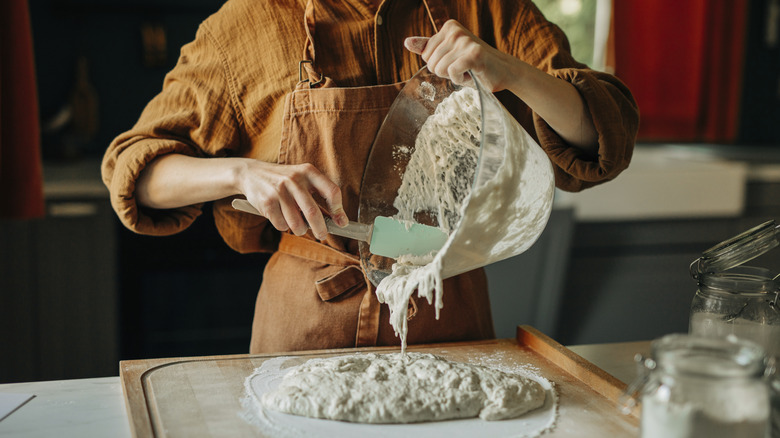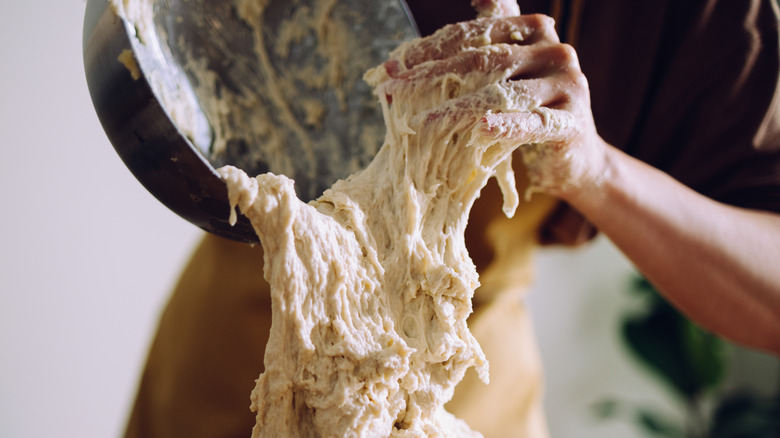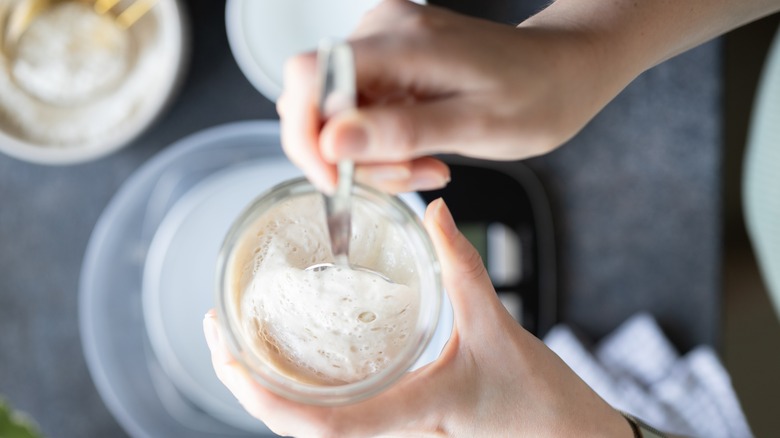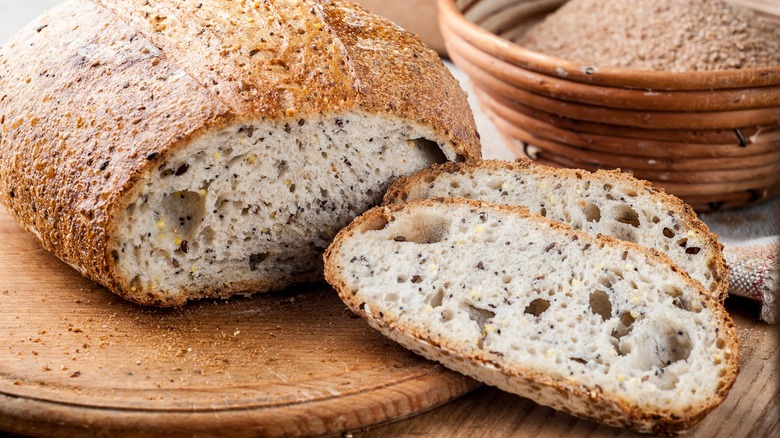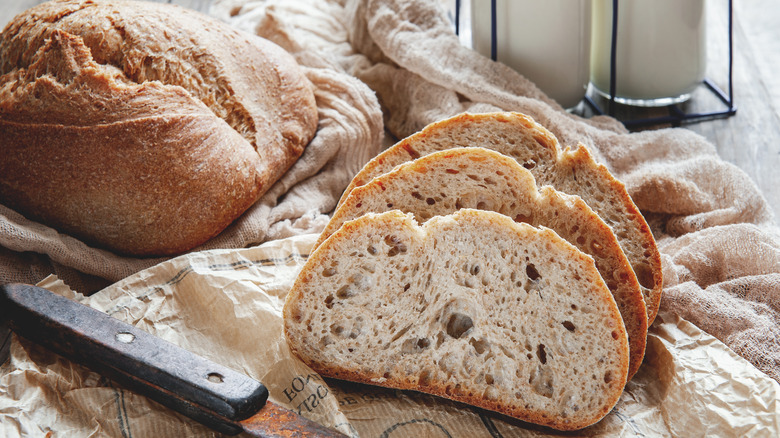Pâte Fermentée Vs Sourdough Starter: What's The Difference?
It's a rite of passage in the baking world. You made a sourdough starter, and this brand-new baby, with its bubbly constitution and bright future helped you bake your first loaf of homemade bread. Just you, that starter, and a recipe from your bread-obsessed neighbor. Welcome to the sourdough lifestyle. Over time, this cozy hobby can turn any budding baker into a budding chemist. Because once you've gotten the hang of using a sourdough starter, you're ready to enter a new circle of bread baking. You've graduated to using pâte fermentée. Like a sourdough starter, pâte fermentée is a bread leavening agent called a preferment. Preferments are mixed with yeast in bread recipes to make most any bread, from baguettes to buns. You've more than likely tasted bread produced with preferments from your favorite pizza spot to your favorite bakery. That's because preferments help bakers to hone in on all the yumminess of bread and not only amplify it but consistently recreate it.
Thanks to chemistry (fermentation) and a little magic (humidity, temperature, luck), both sourdough starters and pâte fermentée influence the time it takes to make bread, as well as its taste and texture. While a sourdough starter is just the thing when you want sourdough bread with a punch, learning how to harness its flavor and texture through an extra round of fermentation will take your bread baking from a hobby to an art.
What is pâte fermentée?
Translated literally from French pâte fermentée means "fermented dough," but it's colloquially known as "old dough." Pâte fermentée is a portion of bread dough reserved from a previous batch of bread so it can ferment by itself before being added to a new batch of dough. There's no starter to feed with this method, and that could be good news for your particular baking needs. The convenience of pâte fermentée is certainly appealing if you're making bread every day.
Mixing old dough with new dough is called indirect fermentation. They are compositions that ferment on their own (indirectly) before being added to the bread dough ingredients. Because pâte fermentée is a piece of fully-formed dough, it's the only preferment that contains salt. It can be used in any bread recipe at this ratio: Add 20% to the weight of your flour, and that's how much pâte fermentée to use. That equals a fifth of the total weight.
What is a sourdough starter?
A sourdough starter is a humble mix of flour and water left out at room temperature (for one to two weeks) that turns into a colony of yeast and lactic acid bacteria. As this colony grows it digests carbohydrates and produces compounds that make bread taste yummy. We use it not only as a way to leaven bread, but as a way to give sourdough bread its unmistakeable tang. Taste for yourself with this recipe for fresh-baked sourdough bread that shows you how to make a sourdough starter. You'll also learn how to make another type of preferment called a levain to produce a fully-flavored but balanced loaf of warm and chewy sourdough bread.
Sourdough starters can live for years when maintained properly. However, its age doesn't impact how sour the bread will taste. It's the health of the starter that makes your bread smell and taste all those delicious ways. To heighten that punch of sourness in your loaves you can use a small amount of whole rye flour (5%) in your recipe and increase the temperature of your water to 90 degrees Fahrenheit. The whole grains and warmer water work to maintain an environment full of acetic acid, and that's where the sour flavor is born.
Pâte fermentée produces less sour flavors and a different crumb
Pâte fermentée, along with all the other types of preferments (there are six) uses less yeast than a sourdough starter, making for a lighter bread. Using less yeast and combining that with longer and slower fermentation times makes bread taste less sour. This is the way to really dial it in when it comes to taste and texture, and once you learn the power of pâte fermentée, you'll see how preferments can improve your homemade bread. As they slow down the fermentation process, they create chemical compounds (acids and esters) that give bread deeper flavors and a finer crumb (the inside of the bread not including the crust). It's a generally-accepted concept in the baking world that the longer bread is allowed to ferment, the better it will be. This is not only true for flavor and mouth feel, but it helps give bread elasticity, too. This makes it easier to shape so that the bread comes out light and full of those gorgeous air pockets.
A sourdough starter isn't just a preferment
You can make sourdough bread directly from a sourdough starter without using the starter as a preferment. That's not how it works with pâte fermentée. Old dough can only be used in an indirect method of fermentation. There is absolutely nothing wrong with preparing bread using only a sourdough starter as a leavening agent, but it will require more kneading to get consistent results. In our recipe for hot honey sourdough bread we use sourdough starter as our only form of yeast to give this delicious treat the perfect amounts of sweetness, spiciness, and tang.
By not using a preferment we are using a bread baking method called direct fermentation or baking with a straight dough. Some bakers believe that straight doughs only use commercial yeast, as opposed to a natural leavening agent like a sourdough starter. But a straight dough refers to the process of mixing all of the ingredients for the dough in one instance. One-step or two-steps, it's your move. Both ways are a happy line-dance that leads straight to delicious, homemade bread.
